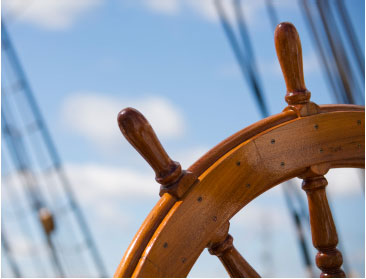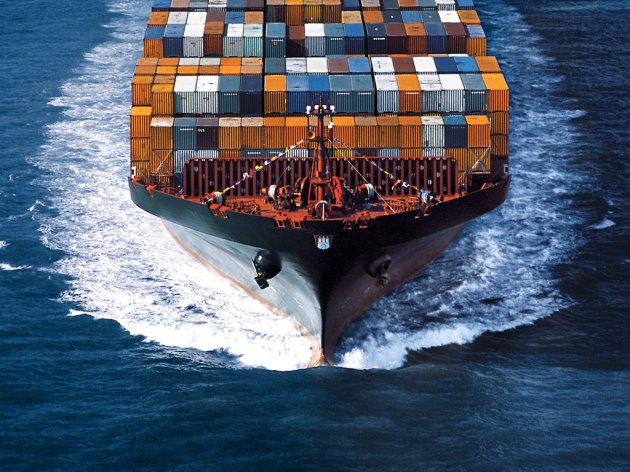What will the Future of Transport and Logistics look like? (Transcript from my presentation at the CILTA AGM in Sept. 2014).
March 27, 2015
What will the future of transport and logistics look like?
This was the theme of a presentation I was asked to participate in at the CILT Australia September 2014 AGM meeting in Melbourne. Below is the transcript of my presentation including the references and necessary links for further reading.
Thanks to CILTA for the invitation and for the participants for their thoughtful and engaging questions that followed.
THE FUTURE OF TRANSPORT AND LOGISTICS – 3 MAIN ELEMENTS UNDER DISCUSSION
There are many things one can discuss when contemplating the future of Transport and Logistics. Today I will focus on Shipping and in particular on three elements that are becoming part of our everyday discussions and which, I think, have the potential to change the industry forever:
- Energy Consumption and Carbon Emissions
- Crewing
- Size and type of vessels.
LEADERSHIP IN THE 21st CENTURY – ENERGY CONSUMPTION AND SHIPPING
Reflecting on the subject I came across Rachel Kyte’s interview to Fran Kelly (Radio National, 29th August 2014). Rachel is the VP of the World Bank responsible for Climate Change. While discussing Leadership, Rachel gave her own definition as follows:
“Leadership in the 21st century is about getting the economic fundamentals right so we drive carbon out of our growth” Rachel Kyte
The Global Financial Crisis (GFC) brought about many devastating effects for economies all around the world. However, the refocusing on fundamentals also brought about new thinking around energy consumption. The vessel charter rates dropped and with fuel been the major expense, shipping lines had to think about new ways of reducing that cost.
So, shipping lines trialed Super Slow Steaming which is the running of a ship’s engine with extra slow revs (MCR as low as 10% – see here). This has its challenges as the engine needs to be cooled down constantly by an air blower so, special arrangements and special agreements and clauses needed to be developed to allocate the risk for this to become reality. Well, this worked and more vessels were introduced in the routes which elongated their lead times and reduced their running cost by reducing speed lower than any such endeavor made before.
The price of Heavy Fuel Oil (which as quality is close to bitumen) keeps on increasing and this trend may well continue (in the mid term) due to the refinement process becoming more efficient leaving less and less fuel for the shipping world (i.e. when LPG, petrol, Jet fuel, Diesel oil etc are drawn from the refinement process a smaller and smaller percentage of Heavy Fuel Oil remains – see here for a diagram of the the refinement process).
So, in 2010, the Classification Society Germanischer Lloyd signed an agreement with Japanese shipbuilder IHI to jointly investigate and develop solutions for large LNG-fueled container ships.
You may be aware of the Searoads built vessel in the Melbourne-Tasmania route which uses LNG and also shipping lines such as CMA CGM who is developing dual fuel vessels (able to burn Heavy Fuel Oil and LNG) and is investing in research for LNG type vessels. The technology is becoming more and more mainstream as Natural Gas becomes available at more locations fast, its price is becoming more competitive, it has good energy density and it offers clear environmental benefits i.e. “elimination of SOX emissions, significant reduction of NOX and particulate matter, and a reduction of GHG emissions” (see here).
All of the above means that carbon emissions are going to reduce (and are already reducing) with shipping lines reporting significant reductions in their carbon output. e.g. CMA CGM reported 40% reduction of CO2 emissions between 2005 and 2013 and also that they are on track for the target of 50% reduction by 2015 (see here).
Apart from the GFC and the obvious economical advantages of developing and introducing alternatives energy sources, legislation has disincentivised the continuation of the current energy consumption styles e.g. ECA Zones in the North Sea and the Baltic sea (see here).
One thing is for sure, that the vessels of tomorrow will be more efficient than today and the carbon emissions (CO2 g/TEU-Km) will reduce.
CREWING – UNMANNED NAVIGATION
It is evident that the global fleet of vessels that carry around 90% of world trade is ever increasing. For the last 10 years the International Maritime Organisation (IMO) has raised alarms for the lack of enough able crew members that can man these vessels as well as the quality of seafarers has been reported to be on the decrease.
At the same time, we see driverless trains, airplane drones controlled with joystics and driverless cars been developed. In Australia, we have semi and fully automatic terminals running already e.g. the Patrick Brisbane Auto strad terminal has been successfully running with Australian developed technology for years.
Sea navigation seems to be more traditional than other industries but it has become apparent that we are reaching a point where shipping will have to consider again the risk/benefit equation and with the technology of today to venture into unmanned navigation.
Today, the European Union is funding 3.5m euro into the MUNIN project (Maritime Unmanned Navigation through Intelligence in Networks). This project will produce a prototype for simulated sea trials to assess the costs and benefits by 2015 (see here).
Moreover, Rolls Royce has entered the discussion (see here). They believe that unmanned navigation vessels may be introduced within a decade in regions such as the Baltic (although global expansion may be slower).
Automation of movement of all means of transportation seems closer than most people think as the technology is presently available and is been refined fast.
SIZE AND TYPE OF VESSELS
The third trend we have been seeing in ship design is the fact that vessels become bigger and bigger. Containerisation started in the mid-1950s with ships that could carry only approx. 50 TEU (Twenty Equivalent Unit). By 1970, 1700 TEU were present and by 2010 13,000 TEU vessels were in the water.
Now, we have the mega vessels of 18,000 TEU and already a 21,000 TEU vessel is been built. The trend will probably continue taking into account that the new upgraded Panama Canal will be able to cater for 13,000 TEU vessels going through, Nicaragua appears to be starting their own project to compete with Panama (an endeavor that has raised many questions), Malacca strait is constrained and the Suez Canal is considering opening a parallel canal to the Suez Canal to ensure constant two way traffic.
The current crane technology been developed has an outreach of 70m (taking into account that the beam of the 18,000 TEU vessels is 59m) there is still scope for growth although limitations of ports to cater for these will make certain ports hubs (e.g. Shanghai) and others, feeder ports (e.g. Melbourne with its ability to effectively only cater up to 7000 TEU vessel designs).
There are of course, many questions to be answered. The answers to which will define the pace and the priorities for innovation and change and the centers of innovation of tomorrow (see Richard Florida’s excellent book The Rise of the Creative Class on a current innovation map of the world).
Which are going to be the markets of tomorrow? At which point will Europe come out of the recession and how much will the demand grow? When will the Chinese economy surpass the US and the Intra-Asia trade lanes surpass the rest? Will the current economic model continue unimpeded or will the global derivatives “bubble” (see the Bank of International Settlements report which reflects their notional value in June 2014 at around the 700 trillion $USD) burst. Will globalisation continue the expansion and how will the creation of the BRICS equivalent “IMF” affect the global trade?
Finally, will 3-D printing take off and if so, will we see less finalised products moving in containers making bulk cargo vessels the next growth area as raw materials will be in demand and large workshops will be used close to the end customer to make the actual product?
When reflecting on topics like this, I remember a story shared by Charlie McDonald, in one of his presentations when he was discussing about how to view the future. The story goes like this:
In 1905, the wise men of London gathered to discuss how London can best equip to face the challenges of the future. It is worth noting that the car had been invented at that time. However, after serious deliberations the wise men came up with three key questions that needed to be answered:
- Where will the horses “park”? (horses was the prevalent transportation of cargo and people medium at the time and the demand was increasing).
- How will all the horses be fed?
- How can the horses s..t be taken care of (as they were becoming a health hazard).
Well, I hope we have learnt our lesson.
The technologies and the questions are today more apparent than the ones contemplated back in 1905 (hopefully). The answers may vary but I believe that the above suggestions and thinking indicates what is likely to happen in the not so far future.
George Vrakas – 24th September 2014



